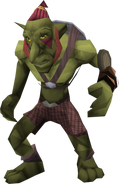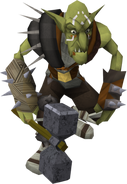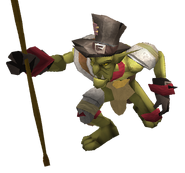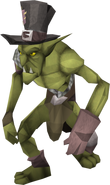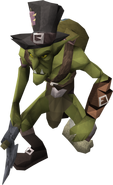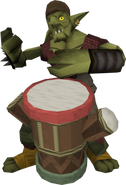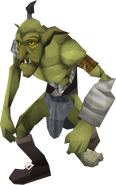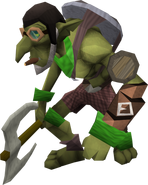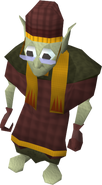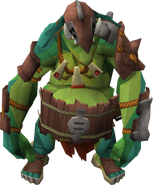This page serves as a source for information about how this subject is applicable to World 42 Roleplay. It may contain Lorebending information and such should not be considered 100% Jagex canon.
|
This page serves as a source of information about various races and tribes of goblins as it is applicable to World-42 roleplaying characters. Everyone is invited to add to this information.
A Brief History[]
The goblin race originally started on their home world Yu'biusk, where the many races that originated on that plane coexisted in peace, that is, until the god Bandos arrived. When bandos arrived on Yu'biusk, he took control over the races of realm, and forced the goblins to fight for his amusement. Those that fought for him and called him their god survived, while those who stood against Bandos were ultimately destroyed. Through this process, as there were no other gods to protect them from Bandos's influence, the goblin race soon came under complete control of the god of war; creating the original race of goblins, from which the other sub-races such as the hobgoblins stemmed, as we know them today.

Yu'biusk, as it was in the past, before Bandos.
As gods began to make their way to Gielinor, so too did Bandos and his chosen races, and the days of the first Gielinorian god wars began for Bandos and his followers. During this time, the goblins thrived and heavily populated many areas of Gielinor. Their numbers became so great that the gnomes were nearly overran, and had to resort to illusion magic to scare their goblin assaulters away. When came the third age, one tribe of goblins, the Dorgeshuun (meaning "the goblins of the strong spears"), was ordered to fight against suicidal odds. The Dorgeshuun, in a remarkably rare moment of disobedience against their god, refused to fight, and instead fled below ground. As two Ages passed, the goblins who fled below ground became a new sub-race from their long existence under the earth; becoming the cave goblins as we know them. Despite having a rough history; civil war, the return of Bandos, and the wrath of his followers after he died, the cave goblins have still managed to survive even after all these years, and successfully continue to do so in their advanced city below Misthalin.
In the Sixth Age, the god of the goblins was finally killed by his rival, Armadyl, and the goblins and other Bandosian races were left without their god. Despite this, they were not saddened by this loss (although some were angered, like the Ourg; General Graardor), they viewed Bandos's death as simply proving his philosophy: the strongest will survive, while the weak perish. Even with the death of Bandos the goblins (excluding the Dorgeshuun) still follow the god's philosophies to this day; happily living a primitive yet hardy existence as they make war and survive against the odds.
Accepted Lore[]
This section addresses details about goblins that are widely accepted throughout the world-42 roleplaying community.
Surface Goblins[]
- Goblins are a bit smaller than humans, usually standing around 5 feet high with their hunched backs.
- However not all goblins are this short, as in the quest "Another Slice of H.A.M." you meet two surface Goblins who are actually taller than the adventurer.
- Most goblins will have dark green or dark brown skin.
- Goblins can be found just about anywhere on the mainland between Isafdar and Morytania.
- Most goblin settlements are similar to military bases (but less organized); they are headed by Generals and populated by armed goblins.
- Surface goblins refer to Bandos as the "Big High War God."
- Goblin priests refer to Bandos by name on holy days.
- Surface goblins believe that those who do not follow the Big High War God, whether they are goblins or other races, must die because the Big High War God commands it. They believe that Bandos made them into mighty warriors.
- Goblins are not allowed to make their own plans, even goblin generals. This is because Bandos' commandments condemn goblins who do so. They are commanded by members of other Bandosian races, or go without tactics if none are available.
- Most goblins try to live an unthinking life of fighting, wars, and bloodshed. They are simple-minded, warlike, easily controlled, and they have been used as basic foot soldiers by many different entities throughout history.
- Surface goblins appear to have only two kinds of leadership - their military leaders (like the Generals at Goblin Village) and their priesthood (as seen in the temple under Hemenster).
- Pride is considered a sin by goblins.
- Deceased High Priests of Bandos (amongst the Goblins) are able to be temporarily resurrected within the crypt of the temple under Hemenster.
- Many goblins are greedy by nature.
- Goblins are hinted to have access to a racially unique set of spells, supposedly conferred upon them by Bandos himself. It is considered heresy for any goblin besides a priest to make use of this natural ability.
Dorgeshuun Goblins[]
- The Dorgeshuun do not look exactly like surface goblins. They have a light green skin, almost white due to not being in the sun. They have enormous eyes, and ears larger than those of elves.

Zanik, a signature Dorgeshuun goblin
- Dorgeshuun goblins can see very well in the dark, though they do still sometimes use light sources.
- Much like elves, Dorgeshuun have hearing that is more crisp than human hearing.
- Because of their cautious, timid culture, most Dorgeshuun will either be very careful and wary of danger or restless and adventurous.
- Dorgeshuun raised in the cave city Dorgesh'Kaan are not raised by their parents. Instead, they are raised with all other Dorgeshuun children in the city nursery. These goblins believe that the status of a child's family should have no effect on what s/he grows up to be.
- Dorgeshuun goblins have the potential to become great fighters as individuals. Once they move past their deep-seated fear of war, they have the intelligence and patience to train and devise strategies.
- Typical Dorgeshuun equipment is made from the resources available in the caves under Lumbridge. Specifically their tools are made of bone and their leather comes from frog skin.
- The Dorgeshuun do not worship any god. They view all gods as evil slave-drivers, especially Bandos.
- Their anti-theistic principles also seem to reflect on Dorgeshuun political principles - instead of a monarchical King or other figure of authority, Dorgesh'Kaan is ruled by a council in a republican format. This hints towards a greater degree of political enlightenment and interest of the Dorgeshuun.
Debated Lore[]
This section addresses details about goblins that are still subject to speculation and discussion either because of conflicting information in-game or because use of the detail in roleplay creates an unfair scenario (usually involving overpowering or another common roleplay problem).
Surface Goblins[]
- They do not put high value on life. (This is not stated explicitly, but tend to kill for frivolous reasons.)
Dorgeshuun Goblins[]
- Curiosity and persistance are rare traits among the Dorgeshuun.
- Many of the Dorgeshuun who leave Dorgesh'Kaan would be ambassadors, heading out to introduce themselves to surface kingdoms.
Common Mistakes[]
This section addresses traits that unexperienced roleplayers often bestow their goblin characters but that aren't actually seen in goblins on Runescape.
- Just because a Dorgeshuun goblin was brave enough to venture out of Dorgesh'Kaan doesn't mean he is brave enough to engage in combat, especially not to help fight a war.
- Dorgeshuun are not all trusting of humans. Some even still disagree with the city's choice to open their doors to the surface-dwellers again.
- This would be exacerbated by the Dorgeshuun conflict with the Humans Against Monsters cult.
- Surface goblins are not all distrusting of humans. While they are opposed to those who do not follow Bandos, this doesn't seem to occur to them when they interact with The Adventurer.
- However, this could be because of the prestige and importance of the Adventurer. Even goblins would have heard of his/her exploits and may respect his/her combative reputation.
Other Information[]
- The Dorgeshuun name, in the ancient goblin language, translates to "Goblins of the Strong Spears."

General Wartface was named for the wart on his face.
- The twelve goblin tribes are the Thorobshuun - "Goblins of the Hills", Garagonshuun -"Goblins of the Sea", Rekeshuun - "Goblins of the North", Drogokishuun - "Goblins of the Fierce Blades", Huzamogaarb - "Live-Flesh Eaters of the Chaos God" (sold to Zamorak during the God Wars), Saragorgak - "Footsoldiers of Shiny Light" (sold to Saradomin during the God Wars), Ekeleshuun - "Goblins of the East", Idithuun - "Goblins of the South", Narogoshuun - "Goblins of the West", Horogothgar - "Eaters of Manflesh", Yurkolgokh - "The Flatulent", and Dorgeshuun - "Goblins of the Strong Spears".
- The Magnushuun are a tribe of goblins who exist exclusively in roleplay.
- The Dorgeshuun tend to be connoisseurs of exotic surface foods.
- Surface goblins seem to be named for their outstanding physical deformities. Grubfoot, General Bentnoze, and General Wartface all follow this pattern.
- Not all names are shown after physical deformities, but of other unpleasant thoughts, such as snotgut.








